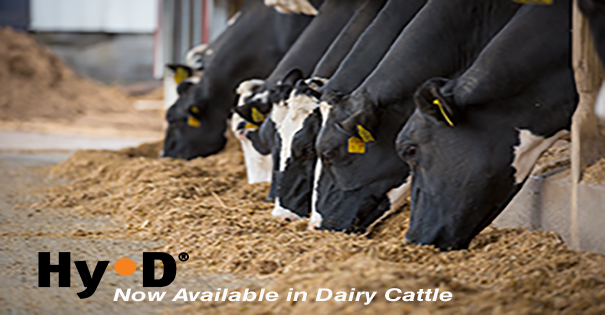New Technology Helps Cows Balance Calcium Demand Throughout the Transition Period
Phibro, DSM Introduce Hy•D® to Complement a Negative DCAD Diet; Help Close the Calcium Gap
Vitamin D supports a variety of physiological functions in dairy cows, from mineral homeostasis to immune activity – and it plays a key role in satisfying a cow’s increased requirement for calcium to support milk synthesis surrounding calving. To help cows better balance this calcium requirement at calving and throughout the transition period, Phibro Animal Health Corporation and DSM have partnered to introduce Hy•D (the 25-hydroxy form of vitamin D3) to the U.S. dairy market. Hy•D is a new source of vitamin D3 specially formulated to help prepare a dairy cow for peak performance.
“We are excited about the DSM and Phibro partnership. When we looked for a partner to be the exclusive distributor for Hy•D in the U.S. dairy market, we wanted to seek out a company with similar values.” said Dr. Mark Engstrom, Essential Products Marketing Manager, North America, DSM. “And the obvious choice was Phibro.”
Hy•D is a proprietary product containing the vitamin D3 metabolite, 25-hydroxyvitamin D3, the immediate precursor to the active form of vitamin D3, 1-25-dihydroxyvitamin D3. The active form of vitamin D3 is essential for the proper orchestration of calcium metabolism, including absorption of calcium from the diet and mobilization of calcium from bone. These two key mechanisms are what the cow relies upon to meet the demand for calcium during the critical transition period and through the first third of lactation.
“During the first nine weeks of lactation, a cow may have a calcium deficit of up to 10 grams per day,” explains Ken Zanzalari, Ph.D., Dipl., ACAN, Product Director, Phibro, “Feeding Hy•D during the close-up period helps to close this calcium gap and support overall health and production.” Eliminating a Physiological “Bottleneck”
When vitamin D is supplemented in the ration, it must go through two metabolic changes to be converted into the active form of the vitamin hormone – first in the liver and second in the kidneys. Inefficiencies in the first step reduce the available circulating pool of 25-hydroxyvitamin D3, which is the precursor to the active form of the hormone, 1,25-dihyroxyvitamin D3. Feeding Hy•D reduces the dependence upon the liver to convert vitamin D3 to 25-hydroxyvitamin D3. The end result of feeding Hy•D is the ability to increase the circulating pool of 25-hydroxyvitamin D3 above what can be obtained by the feeding of vitamin D3 alone. This supports better calcium status during the transition period and improves the overall vitamin D status of the cow, which may provide benefits independent of calcium status.
Improved calcium status of transition cows has been associated with improved cow health and performance. Research has demonstrated that higher blood concentrations of 25-hydroxyvitamin D3 during the transition period helps support calcium homeostasis1, increases some aspects of immune cell function2, increases milk yield in early lactation1,3 and tends to improve reproductive performance.2
“Calcium management isn’t a simple process, and mismanagement can be costly,” says Jamee McNair, Senior Director, Performance Solutions Business North America, DSM. “With Hy•D, we’re able to help producers achieve a more optimal vitamin D status for a more profitable lactation.” Closing the Calcium Gap:
Altering calcium metabolism in the prepartum period to enable the dairy cow to meet the high demand for calcium, mainly for milk synthesis, is an important consideration when formulating prepartum rations. “That’s the reason why the overwhelming majority of dairy producers have adopted some type of hypocalcemia mitigation strategy”. “The most widely accepted practice is the feeding of a negative DCAD diets”, states Dr. Zanzalari. Feeding a negative DCAD diet places a cow in a state of compensated metabolic acidosis. As a result, the tissues responsive to the actions of parathyroid hormone, namely bone and kidney, are more sensitive to the hormone signaling – ultimately leading to increased calcium absorption by digestive tissue and release of stored calcium from bone.
“Now, with the opportunity to feed Hy•D to dairy cattle, dairy producers have another tool to consider”.
Hy•D is now available for use in dairy cattle diets. It’s currently offered as Phibro Hy•D 100 in 49 states and as Phibro HD 100 in Wisconsin. To learn more about Hy•D, talk to your local Phibro Dairy Advisor or visit www.pahc.com/product_services/dairy-cattle/products/
About Phibro Animal Health Corporation
Phibro Animal Health Corporation is a diversified global developer, manufacturer and marketer of a broad range of animal health and mineral nutrition products for livestock, helping veterinarians and farmers produce healthy, affordable food while using fewer natural resources. For more information, visit www.pahc.com.
About DSM
Royal DSM is a global, purpose-led company in Health, Nutrition & Bioscience, applying science to improve the health of people, animals and the planet. DSM’s purpose is to create brighter lives for all. DSM’s products and solutions address some of the world’s biggest challenges while simultaneously creating economic, environmental and societal value for all its stakeholders – customers, employees, shareholders, and society at large. DSM and its associated companies employ approximately 23,000 people around the world and deliver annual net sales of about €10 billion. The company was founded in 1902 and is listed on Euronext Amsterdam. More information can be found at www.dsm.com.




